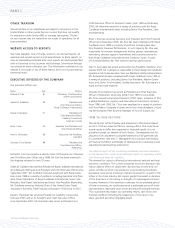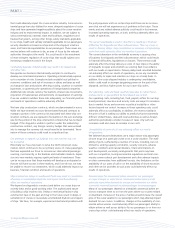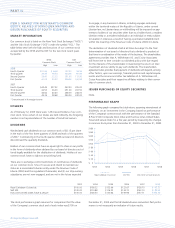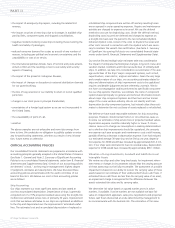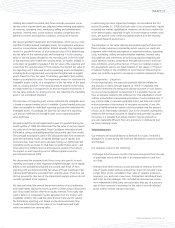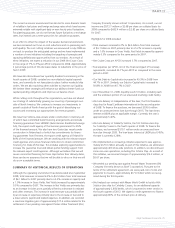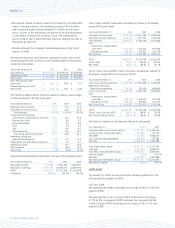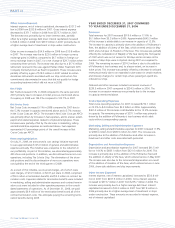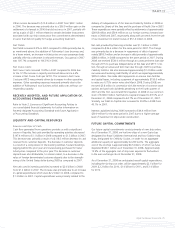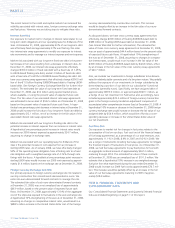Royal Caribbean Cruise Lines 2008 Annual Report Download - page 38
Download and view the complete annual report
Please find page 38 of the 2008 Royal Caribbean Cruise Lines annual report below. You can navigate through the pages in the report by either clicking on the pages listed below, or by using the keyword search tool below to find specific information within the annual report.
22 Royal Caribbean Cruises Ltd.
s the impact of emergency ship repairs, including the related lost
revenue,
s the impact on prices of new ships due to shortages in available ship-
yard facilities, component parts and shipyard consolidations,
s negative incidents involving cruise ships including those involving the
health and safety of passengers,
s reduced consumer demand for cruises as a result of any number of
reasons, including geo-political and economic uncertainties and the
unavailability or cost of air service,
s the international political climate, fears of terrorist and pirate attacks,
armed conflict and the resulting concerns over safety and security
aspects of traveling,
s the impact of the spread of contagious diseases,
s the impact of changes or disruptions to external distribution channels
for our guest bookings,
s the loss of key personnel or our inability to retain or recruit qualified
personnel,
s changes in our stock price or principal shareholders,
s uncertainties of a foreign legal system as we are not incorporated in
the United States,
s the unavailability of ports of call,
s weather.
The above examples are not exhaustive and new risks emerge from
time to time. We undertake no obligation to publicly update or revise
any forward-looking statements, whether as a result of new informa-
tion, future events or otherwise.
CRITICAL ACCOUNTING POLICIES
Our consolidated financial statements are prepared in accordance with
accounting principles generally accepted in the United States of America.
(See Note 1. General and Note 2. Summary of Significant Accounting
Policies to our consolidated financial statements under Item 8. Financial
Statements and Supplementary Data.) Certain of our accounting policies
are deemed “critical,” as they require management’s highest degree
of judgment, estimates and assumptions. We have discussed these
accounting policies and estimates with the audit committee of our
board of directors. We believe our most critical accounting policies
are as follows:
Ship Accounting
Our ships represent our most significant assets and are stated at
cost less accumulated depreciation. Depreciation of ships is generally
computed net of a 15% projected residual value using the straight-line
method over estimated service lives of primarily 30 years. Improvement
costs that we believe add value to our ships are capitalized as additions
to the ship and depreciated over the improvements’ estimated useful
lives. The estimated cost and accumulated depreciation of replaced or
refurbished ship components are written off and any resulting losses
are recognized in cruise operating expenses. Repairs and maintenance
activities are charged to expense as incurred. We use the deferral
method to account for drydocking costs. Under the deferral method,
drydocking costs incurred are deferred and charged to expense on
a straight-line basis over the period to the next scheduled drydock.
Deferred drydock costs consist of the costs to drydock the vessel and
other costs incurred in connection with the drydock which are neces-
sary to maintain the vessel’s class certification. (See Note 2. Summary
of Significant Accounting Policies to our consolidated financial state-
ments under Item 8. Financial Statements and Supplementary Data).
Our service life and residual value estimates take into consideration
the impact of anticipated technological changes, long-term cruise and
vacation market conditions and historical useful lives of similarly-built
ships. In addition, we take into consideration our estimates of the aver-
age useful lives of the ships’ major component systems, such as hull,
superstructure, main electric, engines and cabins. Given the very large
and complex nature of our ships, our accounting estimates related to
ships and determinations of ship improvement costs to be capitalized
require considerable judgment and are inherently uncertain. We do
not have cost segregation studies performed to specifically componen-
tize our ship systems; therefore, we estimate the costs of component
systems based principally on general and technical information known
about major ship component systems and their lives and our knowl-
edge of the cruise vacation industry. We do not identify and track
depreciation by ship component systems, but instead utilize these esti-
mates to determine the net cost basis of assets replaced or refurbished.
We believe we have made reasonable estimates for ship accounting
purposes. However, should certain factors or circumstances cause us
to revise our estimates of ship service lives or projected residual values,
depreciation expense could be materially higher or lower. If circum-
stances cause us to change our assumptions in making determinations
as to whether ship improvements should be capitalized, the amounts
we expense each year as repairs and maintenance costs could increase,
partially offset by a decrease in depreciation expense. If we had reduced
our estimated average 30-year ship service life by one year, deprecia-
tion expense for 2008 would have increased by approximately $31.4 mil-
lion. If our ships were estimated to have no residual value, depreciation
expense for 2008 would have increased by approximately $90.1 million.
Valuation of Long-Lived Assets, Goodwill and Indefinite-Lived
Intangible Assets
We review our ships and other long-lived assets for impairment when-
ever events or changes in circumstances indicate that the carrying amount
of these assets may not be fully recoverable. The assessment of possible
impairment is based on our ability to recover the carrying value of these
assets based on our estimate of their undiscounted future cash flows. If
estimated future cash flows are less than the carrying value of an asset,
an impairment charge is recognized for the difference between the
asset’s estimated fair value and its carrying value.
We determine fair value based on quoted market prices in active
markets, if available. If active markets are not available we base fair
value on independent appraisals, sales price negotiations and projected
future cash flows discounted at a rate determined by management to
be commensurate with the business risk. The estimation of fair value
PART II




